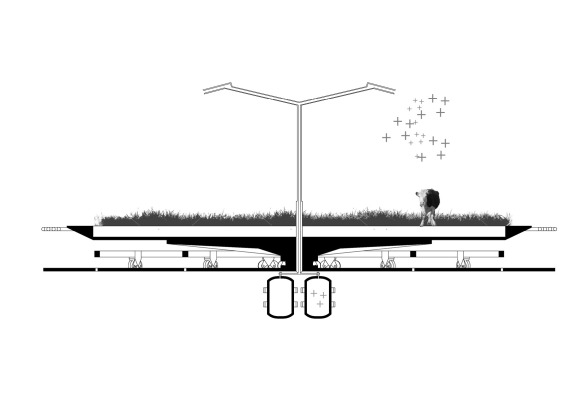We live in an age of a vastly growing population, where the demand for food is growing higher and the available land is shrinking. The approach to organic farming and the beef industry has not radically changed enough for future demands. Ryan Botts from Rice University, steps away from the traditional vertical farm parti, but approaches food production synthesized with dwelling. Creating an urban farm in Chicago that combines the density of city dwelling to the heart of the agricultural world.
STUDENT: Ryan Botts
SCHOOL: Rice University
PROFESSORS: Albert Pope
YEAR: Spring 2011
“The unresolved synthesis between food production and dwelling requires a spatial and programmatic response of equal scale. The current industrial food model, while imposing many problems, continues to expand and fortify the abstraction between production and consumption, farming and food. With an ever-burgeoning world population it is evident that the bucolic naivete of organic farming needs to be met with the earnest design intentions of industrial production. Aggre-Culture refines and hybridizes both the industrial and the residential to create a dynamic response to the ecologies of waste and excess that our current system imposes en masse.
Every new chapter of technological innovation reconstitutes the typological identity of the beef industry. Family farms of only a couple of animals quickly yielded to larger cattle ranches of hundreds of head in the 1830s with the birth of the railroad system. In the midst of World War II cattle ranches began to be synthesized into ever-increasing feedlots located outside the city. The current ecology of waste and excess in the food industry, coupled with new technological findings, demands a new topological overhaul of the existing food industrial model, one with an emphasis on urban forms. The simulacrum of suburban identity is perennially reinforced and diminished by the agricultural substrate that dominates the ground plane of the site. The seasonal shift in crop concentration and rotation is intended to enrich the soil integrity and avoid the risks of monoculture production. This shifting carpet of production platforms causes a reconstitution of relationships amongst the residences. In the summer the substrate is lit verdant green and assembles a global corridor of production. In winter production is reserved to the smaller more technologically-intensive discs.
Because the project is deployed in a part of the world that suffers inclement weather, it became important to illustrate a means of enveloping the livestock. Crowning tessellated collapsible structures house and protect the animals in winter. This also has the double-function of concentrating methane biogas emitted by the animals for more intensified moments of energy harvest (also, perhaps, during winter when climate control begins to draw on the energy reserves of the whole site). Each module perpetrates a number of gestures, whether purely functional, social, or aesthetic (as in the case of the modules with shifted disc-residential relations). ”
-Ryan Botts
All Text and Images via http://arch.rice.edu






Pingback: Aggre-Culture: Chicago's Feedless District – Ryan Botts | FuturesPlus | Vertical Farm - Food Factory | Scoop.it